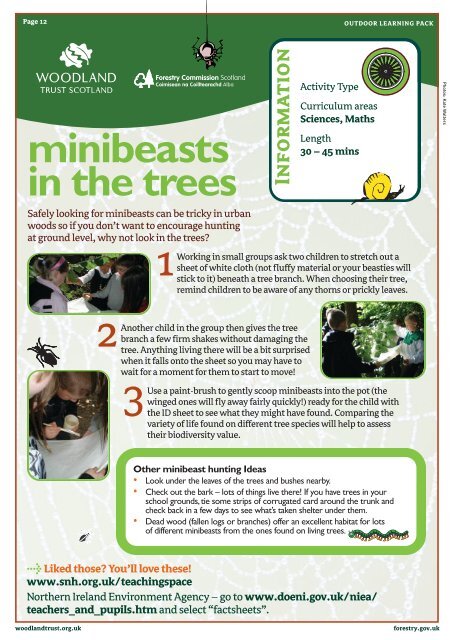2nSbdOqrV
2nSbdOqrV
2nSbdOqrV
You also want an ePaper? Increase the reach of your titles
YUMPU automatically turns print PDFs into web optimized ePapers that Google loves.
Page 12OUTDOOR LEARNING PACKminibeastsin the treesInformationActivity TypeCurriculum areasSciences, MathsLength30 – 45 minsPhotos: Kate WaltersSafely looking for minibeasts can be tricky in urbanwoods so if you don’t want to encourage huntingat ground level, why not look in the trees?Working in small groups ask two children to stretch out asheet of white cloth (not fluffy material or your beasties willstick to it) beneath a tree branch. When choosing their tree,1remind children to be aware of any thorns or prickly leaves.2Another child in the group then gives the treebranch a few firm shakes without damaging thetree. Anything living there will be a bit surprisedwhen it falls onto the sheet so you may have towait for a moment for them to start to move!3Use a paint-brush to gently scoop minibeasts into the pot (thewinged ones will fly away fairly quickly!) ready for the child withthe ID sheet to see what they might have found. Comparing thevariety of life found on different tree species will help to assesstheir biodiversity value.Other minibeast hunting Ideas• Look under the leaves of the trees and bushes nearby.• Check out the bark – lots of things live there! If you have trees in yourschool grounds,tie some strips of corrugated card around the trunk andcheck back in a few days to see what’s taken shelter under them.• Dead wood (fallen logs or branches) offer an excellent habitat for lotsof different minibeasts from the ones found on living trees.> Liked those? You’ll love these!www.snh.org.uk/teachingspaceNorthern Ireland Environment Agency – go to www.doeni.gov.uk/niea/teachers_and_pupils.htm and select “factsheets”.woodlandtrust.org.ukforestry.gov.uk


